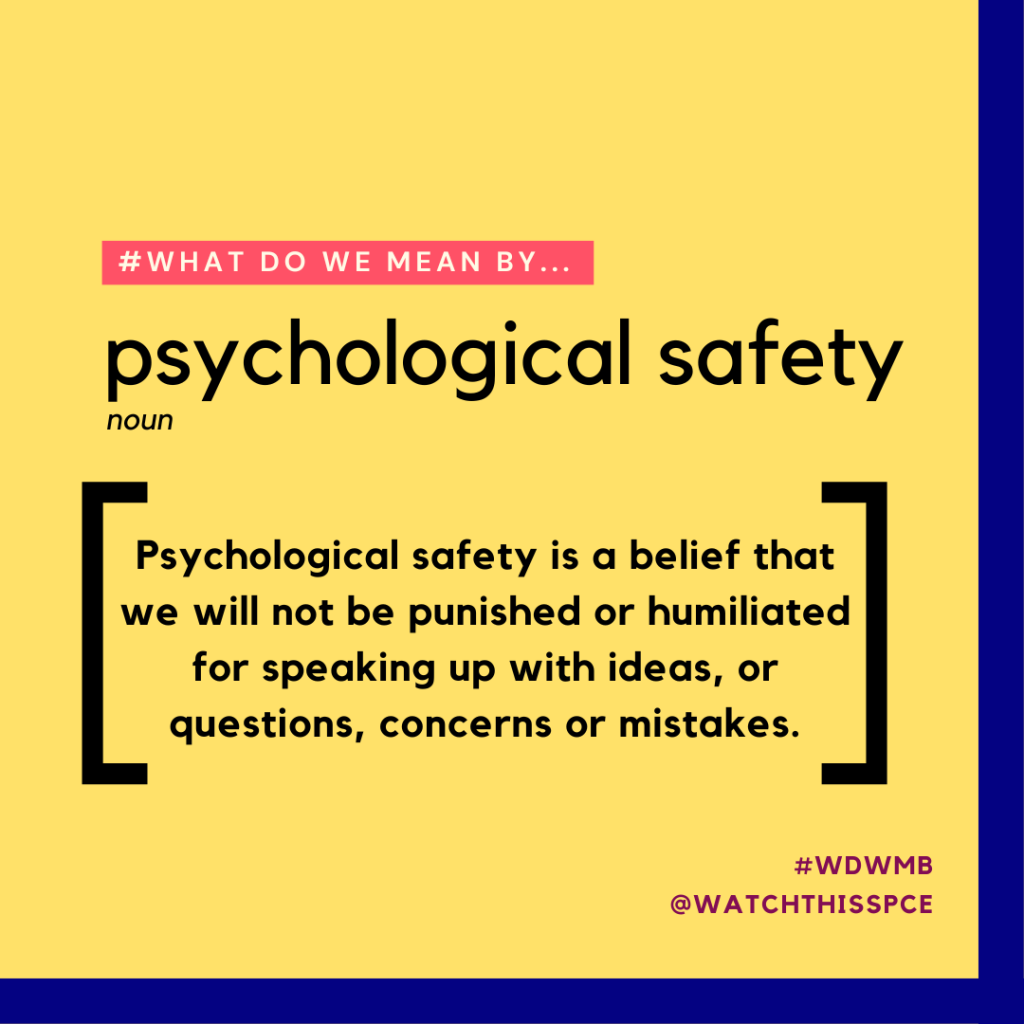When you are working with people how safe do you feel? And by that, I mean how safe do you feel to be yourself? Can you comfortably share your ideas? Are you happy to talk about your life openly? And do you feel you can disagree with people?
Two in five people feel held back to be themselves at work by a fear of failure.
Three in five people are hiding something about themselves from an employer.
And this all comes down to not feeling safe. It’s about not feeling secure enough to be yourself. This is all about something called psychological safety.
When we run our Inclusion Audits, we ask people what words or phrases they are not sure about, and this one often comes up as something people want to know more about. There are different ways of describing it, it essentially comes down to feeling safe and secure to be yourself…and make mistakes.

Psychological safety is a shared belief held by members of a team that the team is safe to take risks and be yourself. This means that people feel comfortable being themselves, expressing their opinions, and taking risks without fear of being punished, or marginalised.
This is important because it enables people to speak up and share their thoughts and ideas without fear. It allows for open and honest communication, which is essential for teamwork and collaboration. When people feel safe to speak up, they are more likely to contribute their best ideas, ask questions, and challenge assumptions, which can lead to better decision-making and problem-solving. If you want the benefits of diverse, inclusive teams where everyone can thrive, then a feeling of safety is essential to that.
Psychological safety can also help foster a positive team culture and increase team cohesion. When people feel that they can trust and rely on each other, they are more likely to work well together and support one another.
There are several factors that can contribute to psychological safety on a team, including:
- Trust: people need to trust each other and feel that they can rely on one another.
- Respect: people should feel that their ideas and opinions are valued and respected by their colleagues.
- Inclusion: people should feel that they are part of the team and that their voices are heard.
- Fairness: people should feel that their contributions are recognised and that the team operates in a fair way.
Creating a psychologically safe environment requires effort and commitment from team leaders and members. It can be helpful to establish clear communication and problem-solving processes, and to encourage open and honest dialogue. It is also important to address any issues or conflicts that might come up. In a psychologically safe culture, it’s OK to make mistakes or to disagree with someone. These are all opportunities for learning.
Belonging
And how does that link to a feeling of belonging? Psychological safety and belonging refer to the feeling of being accepted and included in a group or team, and being able to express yourself without fear of negative consequences. This type of environment allows people to feel comfortable taking risks, making mistakes, and voicing their opinions without fear.
Research has shown that psychological safety and belonging are important for team performance and productivity. When people feel safe and included, they are more likely to communicate openly and honestly, which can lead to better decision-making and problem-solving. When people feel like they belong, they are more likely to be engaged and motivated, which can lead to higher levels of performance. And people who feel safe and that they belong are much more likely to stay in their role.
There are several strategies that leaders and team members can use to foster a sense of psychological safety and belonging within a team or group:
- Open and honest communication: Encourage people to share their thoughts, ideas, and concerns openly and honestly.
- Foster an inclusive culture: Make an effort to include everyone in decision-making processes and ensure that everyone feels like they have a voice.
- Provide support: Offer support to people who may be struggling or in need of help.
- Show appreciation: Recognise and appreciate the contributions of everyone.
- Promote diversity and inclusion: Encourage a diverse and inclusive team culture by welcoming and valuing the perspectives and experiences of everyone.
By fostering a sense of psychological safety and belonging within a team, leaders and team members can create a positive, supportive, and productive work environment.
Leadership styles
A lot of this comes down to leadership styles. Are leaders controlling and supervising people? How open are they to people making mistakes and learning from that? These are the factors that determine whether people feel safe enough to explore ideas.
Leaders need to be able to understand the different needs of teams. How do they handle dominant groups? What about microaggressions? Are people able to feel protected and safe by the leadership style so that they don’t have to hide things about themselves?
In teams where people feel safe, you will see people learning from mistakes, they will share new ideas and crucially, they will share if they are struggling with something and ask for help.
In the end it comes down to trust. If people are trusted to do their roles and share their thoughts and ideas then the environment feels safe for people.
If you and your team want to learn more about this, we have just launched a new training course on Creating Safe Environments. Email hello@watchthisspace.uk
